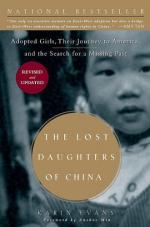
|
| Name: _________________________ | Period: ___________________ |
This test consists of 15 multiple choice questions and 5 short answer questions.
Multiple Choice Questions
1. What message does Max give the adoptive parents before they head out to start collecting official permissions?
(a) "When in Rome, do as the Romans do."
(b) "Make yourself a joy to deal with."
(c) "Do not speak unless spoken to."
(d) "Show no emotion."
2. What do Chinese officials call women who flee their hometowns to give birth?
(a) Birth guerrillas.
(b) Birth smugglers.
(c) Baby guerrillas.
(d) Birth vigilantes.
3. Which of these places is NOT mentioned as a new home of a Chinese baby?
(a) Atlanta.
(b) Boston.
(c) Los Angeles.
(d) Chicago.
4. What is the common name of the system that favors boys over girls?
(a) "Boy preference."
(b) "Son preference."
(c) "Chosen boys."
(d) "Daughter disappointment."
5. What is the popular name of legendary heroine Fa Mu Lan?
(a) Mumu.
(b) Lanxi.
(c) Mulan.
(d) Famu.
6. What is a regional delicacy in Guangzhou that Karin is told tastes like peanuts?
(a) Fried moths.
(b) Fried grasshoppers.
(c) Fried silkworms.
(d) Fried mulberry leaves.
7. In what year does China enact an international adoption law?
(a) 1992.
(b) 1996.
(c) 1990.
(d) 1987.
8. What human tie does Evans call one of the deepest possible?
(a) Between spouses.
(b) Between grandparents and grandchildren.
(c) Between siblings.
(d) Between parent and child.
9. What is the period of Mao Zedong's reforms called?
(a) The New Deal.
(b) The Great Leap Forward.
(c) The Mao Dynasty.
(d) The Golden Age.
10. What is the translation of the name given to many girls born into families without sons?
(a) "Not a boy."
(b) "Extra mouth."
(c) "Bring a little brother."
(d) "Treasured one."
11. What is a natural ratio of boys to girls at birth?
(a) 100:100.
(b) 105:100.
(c) 120:100.
(d) 85:100.
12. Who are "pleaders"?
(a) Men who wanted multiple children to work the land.
(b) Women who begged to keep their children.
(c) Men who were desperate for a son.
(d) Women who wanted more than one child.
13. What is a "hukou"?
(a) A marriage license.
(b) A residence registration card.
(c) An adoption decree.
(d) A birth permission paper.
14. According to a folk tale Karin read, what are adopted children in China sometimes called?
(a) Mulberry wasps.
(b) Boll worm babies.
(c) Children of the wasps.
(d) Children of the mulberry bug.
15. Which of these is NOT mentioned as a place where babies are abandoned?
(a) Railroad stations.
(b) Hospitals.
(c) Schools.
(d) Along roads.
Short Answer Questions
1. In ancient times, what is the other meaning for the Chinese character for "wife"?
2. How many wars of foreign aggression has China endured in the past 300 years?
3. What does Karin bury in her yard?
4. What does it mean when the street vendors call "you liangge yo-o-o"?
5. Where is the author's daughter born?
|
This section contains 430 words (approx. 2 pages at 300 words per page) |

|




